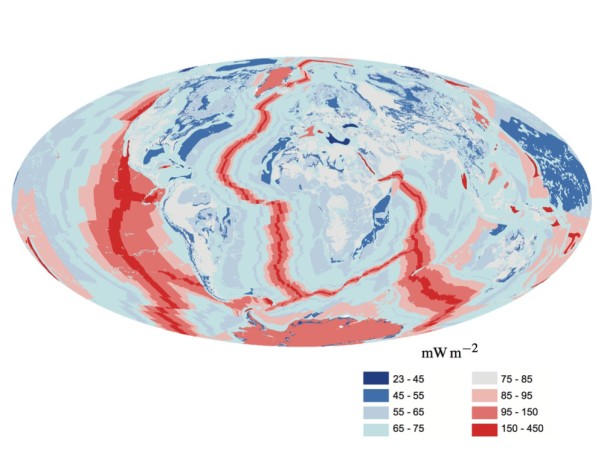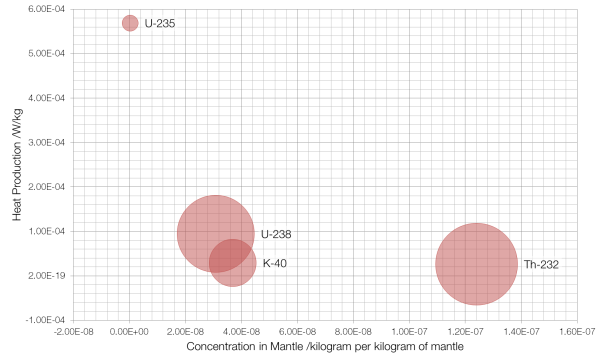Not on the surface, I mean, but underneath? As you dig down into the Earth’s crust you will find yourself getting warmer, at a rate of about 0.025°C per metre of depth (25°C per kilometre). But why?
There are two sources of internal heat that make up the Earth’s internal heat budget: radiogenic heat and primordial heat. This heat flows to the surface at a rate of around 47 terawatts or 92 milliwatts per square metre of surface. This flow is uneven, with more heat flowing at mid-ocean ridges where two tectonic plates move away from each other, and more heat flowing through oceanic crust (which underlies the oceans) than through continental crust (which underlies continental land). The exact contribution of radiogenic v primordial heat to the total is unknown, but is thought to be approximately 50:50.[1]
Radiogenic heat is the heat that comes from the decay of radioactive isotopes in the Earth’s crust and mantle; most of it comes from the decay of four isotopes: potassium-40, thorium-232, and uranium-235 and -238.
Concentration is on the x-axis, with the more common isotopes further to the right, and the y-axis measures the amount of heat produced by each isotope, with “hotter” isotopes towards the top. The area of the bubble is proportional to the amount of heat that isotope contributes per kilogram of mantle, with thorium-232 contributing the most at 3.3 picowatts per kilogram.
Primordial heat is the heat left over from the formation of the Earth. As gas and dust left over from the formation of the Sun coalesced, they lost gravitational potential energy and gained kinetic/thermal energy. The huge amount of initial heat means that Earth is still cooling even now, 4.5 billion years later.
[1] Gando A, Gando Y, Ichimura K, Ikeda H, Inoue K, Kibe Y et al. Partial radiogenic heat model for Earth revealed by geoneutrino measurements. Nature Geoscience. 2011;4(9):647-651.


Hey Mr. Reid you have to update your article mentioning the longest sniper shot. “Firearm Types” published Aug. 9 2014.
Didn’t Lord Kelvin do some calculations in the late 19th Century which purported to show that the Earth, given its rate of cooling and current temperature, could only be a few million years old, thus supposedly refuting the Theory of Evolution?
Yes, but he thought it was hot like a lump of coal. He didn’t know about radiogenic heat.
Are plate tectonics and subduction zones generators of heat because of friction?
I don’t think so no, not in comparison with other sources anyway.
I had what might the same question as did @Doug1843: knowing that Kelvin argued for a very young earth (initially 100 million years, which he later reduced to 20 million) on the basis of primordial heat, how much could be remaining, given that we now know that the actual age is over 4 billion years?
Surprisingly (at least to me), the current heat flow out of the earth’s interior is regarded as split fairly evenly between coming from radiogenic sources and being residual primodorial heat.
One factor is that the core is not expected to be much of a source for radiogenic heat, as it is mostly iron, while the main sources of radiogenic heat (uranium, thorium and potassium) separate out from iron when it is molten. Consequently, its heat, and its contribution to heat flow, is regarded as primodorial. As, however, the core is surrounded by a thick mantle heated by radioactive decay (and more so in the past than now, as the relevant isotopes are used up), I would think one could argue that the core has been kept warm by radioactivity in the mantle, the characterization of its heat as being almost exclusively primordial seems tendentious. After all, heat is a property, not a thing, and it is not as if the core contains some phlogiston that has been there since the earth formed.